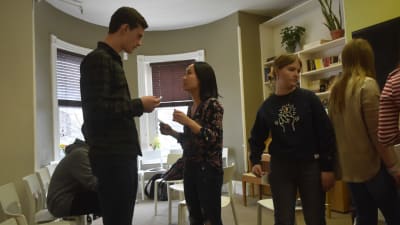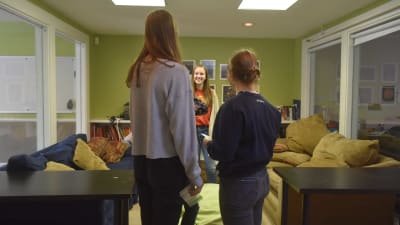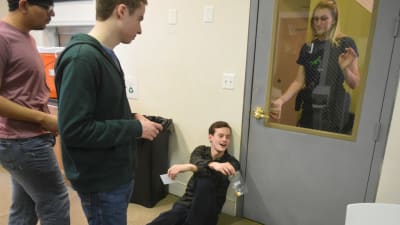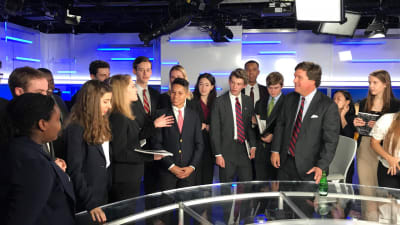Critical Thinking: Week One at SEGL
Our tenth spring semester is off to a roaring and unique start. For the first time in our history we’ve pushed traditional classes to the second week; this allows us to focus on building critical thinking skills that will serve us throughout the semester and beyond. (Along the way, we had a great deal of fun!)
We began the week with some ethical groundwork: The Infamous Skittles Scenario is the first stage of our “Introduction to Ethical Decision Making” case study (and an early SEGL rite-of-passage!). The interactive state-of-nature simulation has students chasing after plastic bags of candy and shouting with delight or dismay at 3×5 “Chance” cards. (What would you do if there were no rules and limited resources? Would you use that gun you found? Help out a suddenly-blind friend? Lie? Join a makeshift band of marauders? Form a “collective” that might turn sour if resources are light?) The conversation that followed was effervescent and pensive.
We then gave the students an introduction to classic Western ethical theory–Aristotle, Kant, and John Stuart Mill–a 20-minute lecture that provides three important tools for their ethical decision making tool kit. (If you would like to see a seven-minute video of this lecture that was made for our online class several years ago, click here.) Later in the week we discussed Carol Gilligan’s feminist critique of moral development theory, In A Different Voice, and we’ll hear from other ethicists as the semester continues.
In the afternoon, students discovered the latest brain science research about learning, and then began their critical thinking work.
SEGL’s basic critical thinking framework is SEE – THINK – ACT – REFLECT. This four-step process helps students evaluate information and choices in our “fake news,” “snap judgments” era. We’ll let the students explain each step in detail, but we spent most of this week learning how to see: Through which filters do we see the world, and how do those filters affect how we gather information? How do we gather information as objectively as possible, without jumping to conclusions?
Our opening critical thinking session was in Lincoln Park (a few blocks from our residence) where we gathered around a sculpture in the park’s center. Should it stay? Be destroyed? Move to another location? Add an explanatory plaque? The session was a fascinating hands-on critical thinking experience, full of twists and turns as students dug beyond their first impressions. (To read Frederick Douglass’s dedication of the monument–itself a model of critical thinking–click here.)
On Wednesday, we turned our focus to the media. Our introduction helped students understand the challenge of modern news production and consumption: after asking each student to write down the news sources she or he used most, we asked all students to arrange those sources on a matrix. On the “x axis” of that matrix was the liberal-conservative spectrum; on the y-axis how reliable each source was. The results were fascinating and showed both assumptions and blind spots in our group’s favorite news sources (the most popular quadrant was “liberal and reliable”–can news be both politically biased and trustworthy?); it also helped create many questions for our guest experts.
We then launched into an investigation of last week’s controversial Lincoln Memorial incident involving students from Covington Catholic high school in Kentucky. The incident is a perfect case study for honing critical thinking, as the initial widely-shared video (which provoked a strong social media and cable news response) included only part of the story. In small groups, the students viewed different first-hand videos of the confrontation, seeing how each changed the narrative. Along the way, they worked hard to avoid jumping to conclusions without appropriate evidence. They also viewed a segment on the altercation from Fox News’ Tucker Carlson Tonight (Carlson would be our Thursday evening speaker) and discussed the narrative that segment proposed.
On Thursday we put our students’ critical thinking skills to the test: a day-long journalism simulation. In groups of four, the students traversed the National Gallery of Art, imagining it was a Central Asian autocracy with a breakaway rebel province. Our faculty played various key leaders in what turned out to be a dramatic series of events. The catch? Through shrewd observation, questioning, and research, our students had to figure out which (if any) of the leaders to believe. The day culminated in three-minute on-the-scene video presentations in which each group decided what to share, and how.
On Thursday night, we trekked to DC’s Fox News headquarters for a live taping of Tucker Carlson Tonight. One of the only media personalities to work for all three of the major cable news networks, Carlson’s 8pm show is one of the most watched in all of cable news (President Trump is a frequent viewer). We began with a tour of the headquarters (as we were walking in, White House advisor Kellyanne Conway was walking out), and then groups of five students each spent one block of the show in Carlson’s studio. Afterward, all the students gathered in the studio for a rapid-fire question-and-answer session (“Are you contributing to the increased political polarization that you lament on your show?”) and a group photo. In a robust reflection session afterwards, students mused about when friendship with a political adversary is appropriate and when it is unethical. The question is at the heart of our current civic discourse.
On Friday, we welcomed three-time Pulitzer Prize-winning journalist Eric Schmitt. Among other distinctions, Schmitt was the New York Times‘ main contact for WikiLeaks founder Julian Assange, and once climbed into Saddam Hussein’s final hiding place (without permission!). Schmitt has ample experience wrestling with the ethical issues our case study raised. The students heard stories, his take on President Trump and the current media landscape, and his advice for news readers in the “fake news” era.
In a few weeks we plan to meet with Abby Phillip, a CNN White House correspondent with direct experience covering the Trump White House. Together, we hope these three speakers will give students a well-rounded understanding of and avenues for further exploration of media ethics in the “fake news” era.
Saturday morning brought our first “Saturday Academy” (a twice-monthly visit to a noted DC landmark): a trip to the Newseum, where students saw pieces of the Berlin Wall and World Trade Center, the famous Pulitzer Prize-winning photo exhibit, and countless other artifacts. (The Newseum itself was recently in the news for its own ethical decision making!)












































